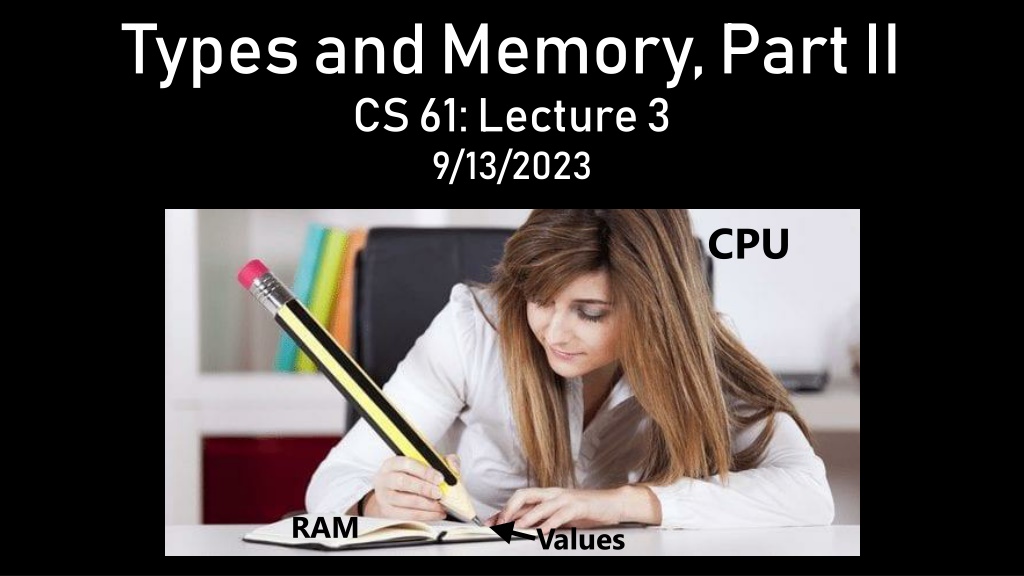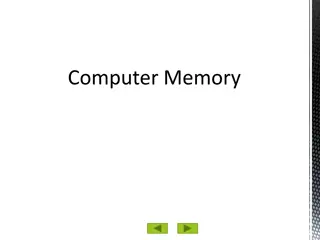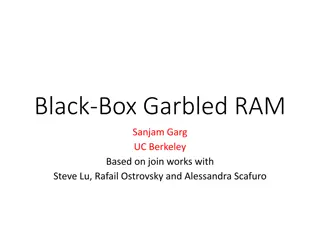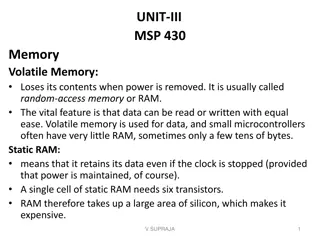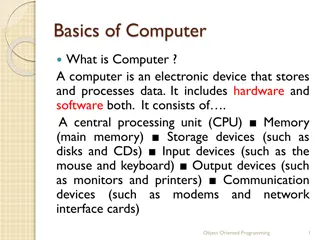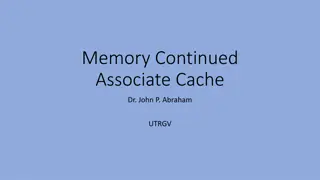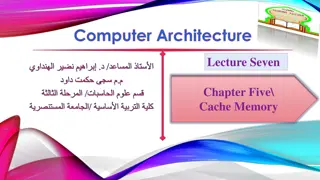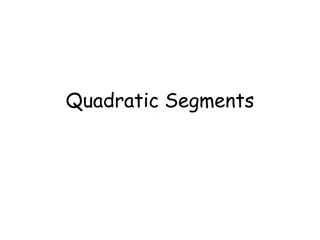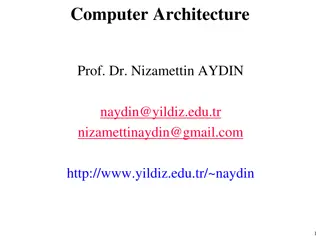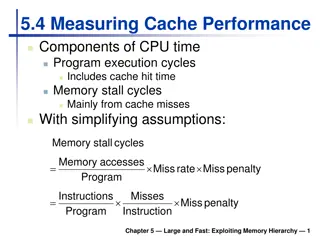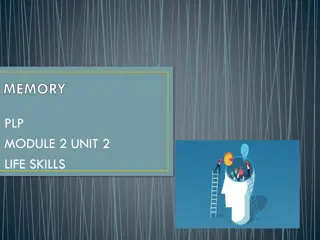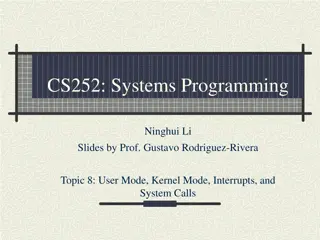Understanding CPU and RAM Relationship in Memory Segments
A program's address space consists of four segments - code, static data, stack, and heap. Each segment plays a crucial role in memory allocation and management. The OS and C++ runtime handle the allocation and deallocation of memory in the heap segment. Garbage collectors in certain languages aid in managing memory efficiently. Learn about the intricacies of memory allocation and deallocation processes in a program.
Download Presentation

Please find below an Image/Link to download the presentation.
The content on the website is provided AS IS for your information and personal use only. It may not be sold, licensed, or shared on other websites without obtaining consent from the author. Download presentation by click this link. If you encounter any issues during the download, it is possible that the publisher has removed the file from their server.
E N D
Presentation Transcript
Types and Memory, Part II CS 61: Lecture 3 9/13/2023 CPU RAM Values
Recap: Memory A program s address space has four segments The code segment code segmentstores the program s CPU instructions The static data segment static data segment contains global variables The stack stack contains bookkeeping information (e.g., local variables) for active functions: More details in the next lecture! The heap heap contains dynamically allocated data The lifetime of a C++ object depends on which segment it lives in! Code and static data is born at program start and only dies when the program dies The compiler automatically ensures that a live function s stack data is created when the function starts, and only lives as long as the function A programmer has to manually allocate and deallocate heap memory via new and delete! Address space Byte N-1 Stack Pulled from executable into RAM during (6) Heap Static data Code Byte 0 SSD
Heap Allocation and Deallocation (Slightly simplified) The OS keeps track of the sizes and locations of the four segments (code, static data, heap, and stack) The C++ runtime C++ runtime tracks the locations of free space in the heap During a call to new <type> . . . If the heap has sizeof(<type>) contiguous free bytes, the C++ runtime simply allocates those bytes Otherwise, the C++ runtime must first invoke a system call like sbrk() to ask the OS to increase the size of the heap During a call to delete <var_name> . . . The C++ runtime deallocates the relevant heap bytes The runtime may also use a system call to shrink the heap, although many runtimes don t do this Garbage collectors in languages like Python, Java, and OCaml A language runtime contains code that is: Provided by the language implementation itself Handles bookkeeping tasks on behalf of developer-written code Examples of runtime code are: C++ new/delete operators that directly handle low-level heap management C++ code which initializes global variables to all-zero bytes C++ IO functionality (e.g., printf(), cout) that provides simplified interfaces to IO-related system calls C++ data structures like vector
Heap Allocation and Deallocation (Slightly simplified) The OS keeps track of the sizes and locations of the four segments (code, static data, heap, and stack) The C++ runtime C++ runtime tracks the locations of free space in the heap During a call to new <type> . . . If the heap has sizeof(<type>) contiguous free bytes, the C++ runtime simply allocates those bytes Otherwise, the C++ runtime must first invoke a system call like sbrk() to ask the OS to increase the size of the heap During a call to delete <var_name> . . . The C++ runtime deallocates the relevant heap bytes The runtime may also use a system call to shrink the heap if there are free bytes at the end of the heap //new operator //calls sbrk(8) //to increase //heap size by //8 bytes //Suppose that //heap has no //free bytes //and then we //do . . . int* p1 = new int; int* p2 = new int; 0x03 0x04 p2 0x1A 0xCA 0x17 *p1 = 389324381; *p2 = 50600650; 0x34 p1 0x9E delete p1; delete p2; 0x5D brk pointer
What happens if the program then does this . . . printf( %d\n , *p1); . . .? UNDEFINED BEHAVIOR == MONSTER PARTY the end of the duration of a region of storage is reached, the values of all pointers representing the address of any part of that region of storage become invalid pointer values. Indirection through an invalid pointer value and passing an invalid pointer value to a deallocation function have undefined behavior. According to the C++ standard, When NOBODY KNOWS WHAT THESE FOUL THINGS WANT DO NOT BRING THEM INTO YOUR LIFE Undefined behavior Undefined behavior
When your program performs an undefined action, your program is not guaranteed to deterministically perform the same behavior (e.g., hang, crash, emit smoke) during each program run. All you know is that something will happen. SOMETHING UNDEFINED.
Q: What happens if you forget to deallocate memory that you no longer need? A: You get a memory leak! THIS WILL HAPPEN TO YOU IN YOUR LIFE.
C++: Primitive Types vs. Compound Types A type describes two things A set of possible values A set of valid operations on those values A primitive type primitive type is not composed of other types (e.g., char, float) A compound type compound type can aggregate one or more primitive types An array represents a collection of values: Having the same type Accessed via indexing A struct represents a collection of values: Having potentially different types Accessed via field names #include <cstdio> #include "hexdump.hh" int main() { int arr[2] = {61, 62}; hexdump_object(arr); struct { int a; int b; char c; char d; } s = {61, 62, 63, 64}; hexdump_object(s); hexdump_object(s.a); return 0; } Console output: 7ffc72c1cc08 3d 00 00 00 3e 00 00 00 |=...>...| 7ffc72c1cbfc 3d 00 00 00 3e 00 00 00 3f 40 00 00 |=...>...?@..| 7ffc72c1cbfc 3d 00 00 00 |=...| Address of starting value Hex representation ASCII representation ^^^^^^^^^^^^ ^^^^^^^^ ^^^^^^
C++: Object Layout The C++ standard restricts how the compiler and runtime can position objects in memory Two objects cannot overlap in memory: a particular byte in memory belongs to no object, or exactly one object #include <cstdio> #include "hexdump.hh" int main() { int arr[2] = {61, 62}; hexdump_object(arr); struct { int a; int b; char c; char d; } s = {61, 62, 63, 64}; hexdump_object(s); hexdump_object(s.a); int p int p int q int q return 0; } Console output: 7ffc72c1cc08 3d 00 00 00 3e 00 00 00 |=...>...| 7ffc72c1cbfc 3d 00 00 00 3e 00 00 00 3f 40 00 00 |=...>...?@..| 7ffc72c1cbfc 3d 00 00 00 |=...|
C++: Object Layout The C++ standard restricts how the compiler and runtime can position objects in memory Two objects cannot overlap in memory: a particular byte in memory belongs to no object, or exactly one object For an array holding elements of type T: Each value is arranged sequentially and back-to- back Given an array with starting address a, the i-th element (i.e., the element a[i]) lives at memory location a + (i * sizeof(T)) The total amount of memory consumed by the array is N * sizeof(T) 0x101 #include <cstdio> #include "hexdump.hh" int main() { int arr[2] = {61, 62}; hexdump_object(arr); struct { int a; int b; char c; char d; } s = {61, 62, 63, 64}; hexdump_object(s); hexdump_object(s.a); Addrs Addrs 0x107 0x106 0x105 0x104 0x103 0x102 return 0; } 0x100 char* a = new char[8]; //new returns 0x100 Console output: 7ffc72c1cc08 3d 00 00 00 3e 00 00 00 |=...>...| 7ffc72c1cbfc 3d 00 00 00 3e 00 00 00 3f 40 00 00 |=...>...?@..| 7ffc72c1cbfc 3d 00 00 00 |=...|
C++: Object Layout The C++ standard restricts how the compiler and runtime can position objects in memory Two objects cannot overlap in memory: a particular byte in memory belongs to no object, or exactly one object For an array holding elements of type T: Each value is arranged sequentially and back-to- back Given an array with starting address a, the i-th element (i.e., the element a[i]) lives at memory location a + (i * sizeof(T)) The total amount of memory consumed by the array is N * sizeof(T) struct fields are laid out sequentially but maybe not adjacently more on this later! #include <cstdio> #include "hexdump.hh" int main() { int arr[2] = {61, 62}; hexdump_object(arr); struct { int a; int b; char c; char d; } s = {61, 62, 63, 64}; hexdump_object(s); hexdump_object(s.a); return 0; } Console output: 7ffc72c1cc08 3d 00 00 00 3e 00 00 00 |=...>...| 7ffc72c1cbfc 3d 00 00 00 3e 00 00 00 3f 40 00 00 |=...>...?@..| 7ffc72c1cbfc 3d 00 00 00 |=...|
C++ Unions #include <cstdio> #include "hexdump.hh" int main() { struct { union { char c; double d; } u; bool is_char; //The tag! } s; s.u.c = J ; s.is_char = true; printf( %zu\t , sizeof(s.u)); printf("%zu\n", sizeof(s.is_char)); printf( %zu\n , sizeof(s)); hexdump_object(s); return 0; } Like a struct, a union aggregates primitive types Unlike a struct, a union only has enough space to store the largest of its contained types! At any given moment, only one of the possible values in a union is valid In practice, unions are often associated with a tag to indicate which union field is valid 8 16 1 Console output:
Hmm . . . if sizeof(s.u) is 8 and sizeof(s.is_char) is 1, then why is sizeof(s) not 8+1=9? The answer is alignment! alignment! On modern computers, a CPU fetches data from RAM in units of cache lines (e.g., 64 bytes on a modern x86-64 processor) If a primitive value spanned two adjacent cache lines, then reading or writing that value would require two RAM accesses (which would be slower than just one) So, the C++ standard imposes alignment restrictions on the locations at which primitives and compound values may start #include <cstdio> #include "hexdump.hh" int main() { struct { union { char c; double d; } u; bool is_char; //The tag! } s; s.u.c = J ; s.is_char = true; printf( %zu\t , sizeof(s.u)); printf("%zu\n", sizeof(s.is_char)); printf( %zu\n , sizeof(s)); hexdump_object(s); return 0; } cache lines 8 16 1 Console output:
Hmm . . . if sizeof(s.u) is 8 and sizeof(s.is_char) is 1, then why is sizeof(s) not 8+1=9? The answer is alignment! alignment! On modern computers, a CPU fetches data from RAM in units of cache lines (e.g., 64 bytes on a modern x86-64 processor) If a primitive value spanned two adjacent cache lines, then reading or writing that value would require two RAM accesses (which would be slower than just one) So, the C++ standard imposes alignment restrictions on the locations at which primitives and compound values may start #include <cstdio> #include "hexdump.hh" int main() { struct { union { char c; double d; } u; bool is_char; //The tag! } s; s.u.c = J ; s.is_char = true; printf( %zu\t , sizeof(s.u)); printf("%zu\n", sizeof(s.is_char)); printf( %zu\n , sizeof(s)); hexdump_object(s); return 0; } cache lines 8 16 7ffea59a86e0 4a 87 9a a5 fe 7f 00 00 01 00 00 00 00 00 00 00 \ |J...............| 1 Console output:
C++: Memory Alignment A type T has an alignment requirement of A if any value of type T must start at a memory address that is evenly divisible by A The C++ standard says that all alignments must be powers of two So, a particular valid alignment is aligned with all smaller alignments Ex: A type with an alignment of 16 bytes also satisfies an alignment of 8 bytes Each primitive type T has an alignment of alignof(T)
C++: Memory Alignment A type T has an alignment requirement of A if any value of type T must start at a memory address that is evenly divisible by A The C++ standard says that all alignments must be powers of two So, a particular valid alignment is aligned with all smaller alignments Ex: A type with an alignment of 16 bytes also satisfies an alignment of 8 bytes Each primitive type T has an alignment of alignof(T) Each element of a compound object must satisfy alignment, so: Array: alignof(T[N]) == alignof(T) Struct: alignof(struct{T0,T1, ,TN}) == maxi(alignof(Ti)) This rule ensures that the first member of the struct is aligned However, aligning subsequent members may require padding A funny side effect is that you can sometimes change a struct s size by reordering its members! padding between members
Padding Example struct { char a; //alignof(char): 1 int b; //alignof(int): 4 short c;//alignof(short):2 char d; //alignof(char): 1 } s; Any starting location for s will satisfy the alignment properties for s.a and s.d However, arbitrary starting locations for s are not guaranteed to ensure alignment for s.b and s.c! So, the compiler pretends that s starts at address 0, and then . . . adds padding between s s members, and possibly adds padding at the end . . . such that: aligned locations for s also result in alignment for all of s s members, and sizeof(s) is a multiple of the alignof(s) struct { char a; //alignof(char): 1 char _pad0[3]; //padding to //make s.b start on //4-byte boundary int b; //alignof(int): 4 short c;//alignof(short):2 char d; //alignof(char): 1 char _pad1[1]; //padding to //make sizeof(s) a //multiple of the //alignment (which //is 4, because that //is the largest //alignment of any //struct member }; //sizeof(s): 12 //alignof(s): 4
Alignment is the reason that sizeof(s) is 16! The largest alignment of any element in s is alignof(double) == 8 So, s s alignment is 8 The natural (i.e., unpadded) size of s is 8+1 = 9, but 9 is not evenly divisible by s s alignment 8, so we must pad the object to be 16 bytes #include <cstdio> #include "hexdump.hh" int main() { struct { union { char c; double d; } u; bool is_char; //The tag! } s; s.u.c = J ; s.is_char = true; printf( %zu\t , sizeof(s.u)); printf("%zu\n", sizeof(s.is_char)); printf( %zu\n , sizeof(s)); hexdump_object(s); return 0; } 8 16 7ffea59a86e0 4a 87 9a a5 fe 7f 00 00 01 00 00 00 00 00 00 00 \ |J...............| 1 .is_char .u.c (the J char) Padding! Console output:
The C++ standard requires that the expression new T will return an address that satisfies alignof new T (T)! alignof(T) malloc(size) malloc(size) must return memory that is aligned for any object! In practice, this means that the memory must satisfy alignof alignof(std:: (std::max_align_t max_align_t) == 16 ) == 16 on x86-64!
